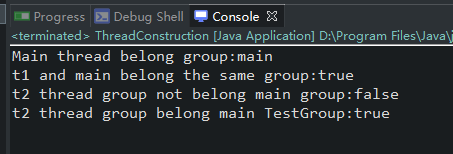本文参考汪文君著:Java高并发编程详解。
1、线程的命名
在构造现成的时候可以为线程起一个名字。但是我们如果不给线程起名字,那线程会有一个怎样的命名呢?
这里我们看一下Thread的源代码:
public Thread(ThreadGroup group, Runnable target) { init(group, target, "Thread-" + nextThreadNum(), 0); } /** * Allocates a new {@code Thread} object. This constructor has the same * effect as {@linkplain #Thread(ThreadGroup,Runnable,String) Thread} * {@code (null, null, name)}. * * @param name * the name of the new thread */ public Thread(String name) { init(null, null, name, 0); } /** * Allocates a new {@code Thread} object. This constructor has the same * effect as {@linkplain #Thread(ThreadGroup,Runnable,String) Thread} * {@code (group, null, name)}. * * @param group * the thread group. If {@code null} and there is a security * manager, the group is determined by {@linkplain * SecurityManager#getThreadGroup SecurityManager.getThreadGroup()}. * If there is not a security manager or {@code * SecurityManager.getThreadGroup()} returns {@code null}, the group * is set to the current thread's thread group. * * @param name * the name of the new thread * * @throws SecurityException * if the current thread cannot create a thread in the specified * thread group */ public Thread(ThreadGroup group, String name) { init(group, null, name, 0); }
如果没有为线程起名字,那么线程将会以“Thread-”作为前缀与一个自增数字进行组合,这个自增数字在整个JVM进程中将会不断自增:
如果我们执行以下代码:
import java.util.stream.IntStream; public class Test { public static void main(String[] args) { IntStream.range(0,5).boxed() .map( i->new Thread( ()->System.out.println( Thread.currentThread().getName() ) ) ).forEach(Thread::start); } }
这里使用无参的构造函数创建了5个线程,并且分别输出了各自的名字:

其实Thread同样提供了这样的构造函数。如下
Thread(Runnable target,String name);
Thread(String name);
Thread(ThreadGroup group,Runnable target,String name);
Thread(ThreadGroup group,Runnable target,String name,long stackSize);
Thread(ThreadGroup group,String name);
下面是实现代码:
import java.util.stream.IntStream; public class Test2 { private final static String PREFIX="ALEX-"; public static void main(String[] args) { IntStream.range(0,5).mapToObj(Test2::createTHREAD).forEach(Thread::start); } private static Thread createTHREAD(final int intName) { return new Thread(()->System.out.println(Thread.currentThread().getName()),PREFIX+intName); } }
运行效果:

需要注意的是,不论你使用的是默认的命名还是特殊的名字,在线程启动之后还有一个机会可以对其进行修改,一旦线程启动,名字将不再被修改,下面是setName源码:
public final synchronized void setName(String name) { checkAccess(); if (name == null) { throw new NullPointerException("name cannot be null"); } this.name = name; if (threadStatus != 0) { setNativeName(name); } }
2、线程的父子关系
Thread的所有构造函数,最终都会调用一个init,我们截取代码片段对其分析,不难发现新创建的任何一个线程都会有一个父线程:
private void init(ThreadGroup g, Runnable target, String name, long stackSize, AccessControlContext acc, boolean inheritThreadLocals) { if (name == null) { throw new NullPointerException("name cannot be null"); } this.name = name; Thread parent = currentThread();//在这里获取当前线程作为父线程 SecurityManager security = System.getSecurityManager(); if (g == null) { /* Determine if it's an applet or not */ /* If there is a security manager, ask the security manager what to do. */ if (security != null) { g = security.getThreadGroup(); } /* If the security doesn't have a strong opinion of the matter use the parent thread group. */ if (g == null) { g = parent.getThreadGroup(); } } /* checkAccess regardless of whether or not threadgroup is explicitly passed in. */ g.checkAccess(); /* * Do we have the required permissions? */ if (security != null) { if (isCCLOverridden(getClass())) { security.checkPermission(SUBCLASS_IMPLEMENTATION_PERMISSION); } } g.addUnstarted(); this.group = g; this.daemon = parent.isDaemon(); this.priority = parent.getPriority(); if (security == null || isCCLOverridden(parent.getClass())) this.contextClassLoader = parent.getContextClassLoader(); else this.contextClassLoader = parent.contextClassLoader; this.inheritedAccessControlContext = acc != null ? acc : AccessController.getContext(); this.target = target; setPriority(priority); if (inheritThreadLocals && parent.inheritableThreadLocals != null) this.inheritableThreadLocals = ThreadLocal.createInheritedMap(parent.inheritableThreadLocals); /* Stash the specified stack size in case the VM cares */ this.stackSize = stackSize; /* Set thread ID */ tid = nextThreadID(); }
上面的代码中的currentThread()是获取当前线程,在线程的生命周期中,线程的最初状态为NEW,没有执行start方法之前,他只能算是一个Thread的实例,并不意味着一个新的线程被创建,因此currentThread()代表的将会是创建它的那个线程,因此我们可以得出以下结论:
- 一个线程的创建肯定是由另一个线程完成的
- 被创建线程的父线程是创建它的线程
我们都知道main函数所在的线程是由JVM创建的,也就是main线程,那就意味着我们前面创建的所有线程,其父线程都是main线程。
3、Thread与ThreadGroup
在Thread的构造函数中,可以显式地指定线程的Group,也就是ThreadGroup。
在Thread的源码中,我们截取片段。
SecurityManager security = System.getSecurityManager(); if (g == null) { /* Determine if it's an applet or not */ /* If there is a security manager, ask the security manager what to do. */ if (security != null) { g = security.getThreadGroup(); } /* If the security doesn't have a strong opinion of the matter use the parent thread group. */ if (g == null) { g = parent.getThreadGroup(); } }
通过对源码的分析,我们不难看出,如果没指定一个线程组,那么子线程将会被加入到父线程所在的线程组,下面写一个简单的代码来测试一下:
package concurrent.chapter02; public class ThreadConstruction { public static void main(String[] args) { Thread t1 = new Thread("t1"); ThreadGroup group = new ThreadGroup("TestGroup"); Thread t2 = new Thread(group,"t2"); ThreadGroup mainThreadGroup = Thread.currentThread().getThreadGroup(); System.out.println("Main thread belong group:"+mainThreadGroup.getName()); System.out.println("t1 and main belong the same group:"+(mainThreadGroup==t1.getThreadGroup())); System.out.println("t2 thread group not belong main group:"+(mainThreadGroup==t2.getThreadGroup())); System.out.println("t2 thread group belong main TestGroup:"+(group==t2.getThreadGroup())); } }
运行结果如下所示:

通过上面的例子,我们不难分析出以下结论:
main 线程所在的ThreadGroup称为main
构造一个线程的时候如果没有显示地指定ThreadGroup,那么它将会和父线程拥有同样的优先级,同样的daemon。
在这里补充一下Thread和Runnable的关系。
Thread负责线程本身的职责和控制,而runnable负责逻辑执行单元的部分。
4、Thread与JVM虚拟机栈
stacksize
在Thread的构造函数中,可发现有一个特殊的参数,stackSize,这个参数的作用是什么呢?
一般情况下,创建线程的时候不会手动指定栈内存的地址空间字节数组,统一通过xss参数进行设置即可,一般来说stacksize越大,代表正在线程内方法调用递归的深度就越深,stacksize越小代表着创建的线程数量越多,当然这个参数对平台的依赖性比较高,比如不同的操作系统,不同的硬件。
在有些平台下,越高的stack设定,可以允许的递归深度就越多;反之,越少的stack设定,递归深度越浅。
JVM内存结构
虽然stacksize在构造时无需手动指定,但是我们会发现线程和栈内存的关系非常密切,想要了解他们之间到底有什么必然联系,就需要了解JVM的内存分布机制。
JVM在执行Java程序的时候会把对应的物理内存划分成不同的内存区域,每一个区域都存放着不同的数据,也有不同的创建与销毁时机,有些分区会在JVM启动的时候就创建,有些则是在运行时才会创建,比如虚拟机栈,根据虚拟机规范,JVM内存结构如图所示。

1、程序计数器
无论任何语言,其实最终都说需要由操作系统通过控制总线向CPU发送机器指令,Java也不例外,程序计数器在JVM中所起的作用就是用于存放当前线程接下来将要执行的字节码指令、分支、循环、跳转、异常处理等信息。在任何时候,一个处理器只执行其中一个线程的指令,为了能够在CPU时间片轮转切换上下文之后顺利回到正确的执行位置,每条线程都需要具有一个独立的程序计数器,各个线程互不影响,因此JVM将此块内存区域设计成了线程私有的。
2、Java虚拟机栈
这里需要重点介绍内存,因为与线程紧密关联,与程序计数器内存相类似,Java虚拟机栈也是线程私有的,他的生命周期与线程相同,是在JVM运行时所创建的,在线程中,方法在执行的时候都会创建一个名为stack frame的数据结构,主要用于存放局部变量表、操作栈、动态链接,方法出口等信息。
每一个线程在创建的时候,JVM都会认为其创建对应的虚拟机栈,虚拟机栈的大小可以通过-xss来配置,方法的调用是栈帧被压入和弹出的过程,同等的虚拟机栈如果局部变量表等占用内存越小,则可被压入的栈帧就会越多,反之则可被压入的栈帧就会越少,一般将栈帧内存的大小成为宽度,而栈帧的数量称为虚拟机栈的深度。
3、本地方法栈
Java中提供了调用本地方法的接口(java Native Interface),也就是可执行程序,在线程的执行过程中,经常会碰到调用JNI方法,JVM为本地方法所划分的内存区域便是本地方法栈,这块内存区域其自由度非常高,完全靠不同的JVM厂商来实现,Java虚拟机规范并未给出强制的规定,同样他也是线程私有的内存区域。
4、堆内存
堆内存是JVM中最大的一块内存区域,被所有线程所共享,Java在运行期间创造的所有对象几乎都放在该内存区域,该内存区域也是垃圾回收器重点照顾的区域,因此有时候堆内存被称为“GC堆”。堆内存一般会被细分为新生代和老年代,更细致的划分为Eden区,FromSurvivor区和To Survivor区。
5、方法区
方法区也是被多个线程所共享的内存区域,它主要用于存储已经被虚拟机加载的类信息、常量、静态变量、即时编译器编译后的代码等数据,虽然在Java虚拟机规范中,将堆内存划分为对内存的一个逻辑分区,但是它还是经常被称作“非堆”,有时候也被称为“持久代”,主要是站在垃圾回收器的角度进行划分,但是这种叫法比较欠妥,在HotSpot JVM中,方法区还会被细划分为持久代和代码缓存区,代码缓存区主要用于存储编译后的本地代码(和硬件相关)以及JIT 编译器生成的代码,当然不同的JVM会有不同的实现。
6、Java 8 元空间
上述内容大致的介绍了JVM的内存划分,在JDK1.8版本以前的内存大致都是这样划分的,但是从JDK1.8来,JVM的内存区域发生了一些改变,实际上是持久代内存被彻底删除,取而代之的是元空间。
综上,虚拟机栈内存是线程私有的,也就是说每一个线程都会占有指定的内存大小,我们粗略的认为一个Java进程的内存大小为:堆内存+线程数量*栈内存。
不管是32位操作系统还是64位操作系统,一个进程最大内存是有限制的。简单来说 线程的数量和虚拟机栈的大小成反比。
5、守护线程
守护线程是一类比较特殊的线程,一般用于处理一些后台的工作,比如JDK的垃圾回收线程。
JVM在什么情况下会退出。
在正常情况下,JVM中若没有一个非守护线程,则JVM的进程会退出。
这和操作系统的线程概念如出一辙。
什么是守护线程?我们看下下面的代码:
public class DaemonThread { public static void main(String[] args) throws InterruptedException { Thread thread = new Thread(()-> { while(true) { try { Thread.sleep(1); }catch(Exception e) { e.printStackTrace(); } } }); thread.start(); Thread.sleep(2_000L); System.out.println("Main thread finished lifestyle"); } }
执行这段代码之后,我们会发现,JVM永远不会结束。
package concurrent.chapter02; public class DaemonThread { public static void main(String[] args) throws InterruptedException { Thread thread = new Thread(()-> { while(true) { try { Thread.sleep(1); }catch(Exception e) { e.printStackTrace(); } } }); thread.setDaemon(true); thread.start(); Thread.sleep(2_000L); System.out.println("Main thread finished lifestyle"); } }
我们加了个thread.setDaemon(true)之后,程序就在main结束后正常推出了。
注意:
设置守护线程的方法很简单,调用setDaemon方法即可,true代表守护线程,false代表正常线程。
线程是否为守护线程和他的父线程有很大的关系,如果父线程是正常的线程,则子线程也是正常线程,反之亦然,如果你想要修改他的特性则可借助setDaemon方法。isDaemon方法可以判断该线程是不是守护线程。
另外要注意的是,setDaemon方法旨在线程启动之前才能生效,如果一个线程已经死亡,那么再设置setDaemon就会抛出IllegalThreadStateException异常。
守护线程的作用:
在了解了什么是守护线程以及如何创建守护线程之后,我们来讨论一下为什么要有守护线程,以及何时使用守护线程。
通过上面的分析,如果一个JVM进程中没有一个非守护线程,那么JVM就会退出,就是说守护线程具备自动结束生命周期的特性,而非守护线程则不具备这个特点,试想一下弱国JVM进程的垃圾回收线程是非守护线程,如果main线程完成了工作,则JVM无法退出,因为垃圾回收线程还在正常的工作。再比如有一个简单的游戏程序,其中有一个线程正在与服务器不断地交互以获得玩家最新的金币,武器信息,若希望在退出游戏客户端的时候,这些数据的同步工作也能够立即结束等等。
守护线程经常用作与执行一些后台任务,因此有时称他为后台线程,当你希望关闭某些线程的时候,这些数据同步的工作也能够立即结束,等等。
守护线程经常用作执行一些后台任务,因此有时它也被称为后台线程,当你希望关闭这些线程的时候,或者退出JVM进程的时候,一些线程能够自动关闭,此时就可以考虑用守护线程为你完成这样的工作。
总结:
学习了Thread的构造函数,能够理解线程与JVM内存模型的关系,还明白了什么是守护线程。